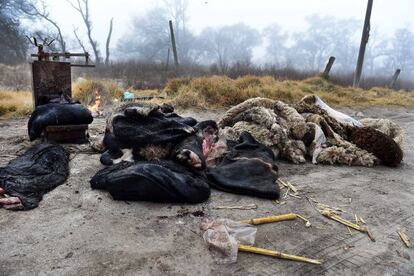Mexico’s animal hell
Every Monday livestock is sold at the San Bernabé market in appalling conditions


A horse lies on a bed of straw and feces, his jaw broken after being thrown from a two-meter height. His mouth spouts blood like a leaky faucet, but even though this is not his most serious wound, he has now decided to give up. Standing on either side, two men whip him to try to get him to stand up. The animal doesn’t even flinch. His backbone tenses under his scaly brown skin, which is full of sores.
Just a few meters from this scene, several white arches with blue letters bid visitors “Welcome to San Bernabé Market.”
Here in the rural Mexican town of Almoloya de Juárez, population 147,653, amid cornfields often covered in thick fog, an animal auction takes place every Monday. It is one of the largest such events in central Mexico, putting over 3,000 animals up for sale each week.
They all arrive here in overcrowded cattle trucks and get unloaded with kicks and blows. The Mexican Association of Animal Protection Societies (APASDEM) has released a video recorded by a US animal rights group, The Animal Recovery Mission, showing the extreme conditions in which the animals are taken to market.
US organization ARM’s Operation San Bernabé video.
Beyond the welcome arches lie nearly eight hectares of wasteland dotted with dozens of trucks that got here before daybreak to unload their stock. San Bernabé is like a junkyard: animal rejects get sold here. A truck makes the rounds of the nearby towns every week, picking up unwanted cattle to sell. A lot of the cattle are stolen, says a transit police officer inspecting the vehicles as they exit the market.
Most of the animals on sale are destined for human consumption, yet no health certificates are on view anywhere.
“It is very common for animals to get sacrificed in a courtyard or resold at clandestine slaughterhouses,” says APASDEM lawyer Vanessa Calvillo.
The “estate administrator” says animal welfare is the market’s utmost concern
Although Mexico has animal welfare laws, here they are violated in plain view.
“The law is very ambiguous about who has the power to condemn [wrongdoers],” explains Calvillo. Representatives from the Agriculture and Livestock Department are usually on hand and have the power to extend sanctions, says the lawyer. But nobody from that department would talk to EL PAÍS about the issue.
Things get even more confusing when you try to find out who is in charge of the market. Very few people know the owner, and those who do keep quiet.
At the entrance, the drivers of the cattle trucks hand coins over to men standing in the back of a gray pick-up. Nobody gets a receipt. The security staff consists of a woman of around 60 wearing a neckerchief that covers all but her eyes who helps vehicles park and radios her superiors if she sees anything suspicious.

A short man with several silver teeth approaches the circle of people around the horse on the ground. His name is Bartolo López and he defines himself as the “estate administrator.” Standing in front of that gruesome scene, he says animal welfare is the market’s utmost concern.
Soon after that, a veterinarian shows up – one of just three assigned to check on the 3,000 animals that pass through here every week. He has no kit with him, just a red bottle and a syringe inside his coat pocket.
They manage to haul the horse up into the truck and tie his tail to one of the metal bars on the trailer
—Sir, how far do you want the horse to go?
—To the truck there, around 40 meters.
Based on the distance, the vet applies the necessary dose of painkillers. A short while later, they manage to haul the horse up into the truck and tie his tail to one of the metal bars on the trailer. Several more animals will get carried away in it.
Tu suscripción se está usando en otro dispositivo
¿Quieres añadir otro usuario a tu suscripción?
Si continúas leyendo en este dispositivo, no se podrá leer en el otro.
FlechaTu suscripción se está usando en otro dispositivo y solo puedes acceder a EL PAÍS desde un dispositivo a la vez.
Si quieres compartir tu cuenta, cambia tu suscripción a la modalidad Premium, así podrás añadir otro usuario. Cada uno accederá con su propia cuenta de email, lo que os permitirá personalizar vuestra experiencia en EL PAÍS.
¿Tienes una suscripción de empresa? Accede aquí para contratar más cuentas.
En el caso de no saber quién está usando tu cuenta, te recomendamos cambiar tu contraseña aquí.
Si decides continuar compartiendo tu cuenta, este mensaje se mostrará en tu dispositivo y en el de la otra persona que está usando tu cuenta de forma indefinida, afectando a tu experiencia de lectura. Puedes consultar aquí los términos y condiciones de la suscripción digital.
Últimas noticias
Most viewed
- Reinhard Genzel, Nobel laureate in physics: ‘One-minute videos will never give you the truth’
- Pablo Escobar’s hippos: A serious environmental problem, 40 years on
- Charles Dubouloz, mountaineering star, retires at 36 with a farewell tour inspired by Walter Bonatti
- Why we lost the habit of sleeping in two segments and how that changed our sense of time
- The Florida Keys tourist paradise is besieged by immigration agents: ‘We’ve never seen anything like this’








































